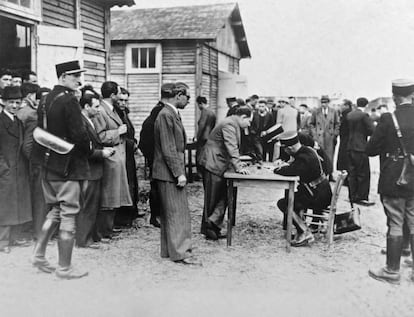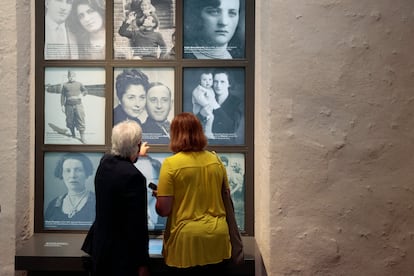Survivors of mass Vel d’Hiv roundup of Jews in France: ‘We hope that young people will remember our story’
Sunday marked the 80th anniversary of the mass arrest of 13,000 Jewish people in Paris, an event that was commemorated amid fears of the rise of anti-Semitism

As a child, Arlette Testyler was told by her father, a Jew of Polish origin, that if she had any problems, she should look for a police officer. After all, they were in France, “the country of Voltaire, [Émile] Zola, human rights,” recalled the 89-year-old. Everything changed with the Nazi occupation of France in 1940 and the collusion of the Vichy regime, the French government proclaimed by Marshal Philippe Pétain following the country’s military defeat. In 1942, French authorities carried out the largest roundup of Jews in Western Europe during World War II. Nearly 13,000 Jews, most of them women and children like Testyler, were arrested between July 16 and 17 in the so-called Vel’ d’Hiv Roundup, named so after the Vélodrome d’Hiver, an indoor sports arena in Paris, where the detainees were held. The operation was coordinated by the French collaborationist authorities and carried out by 4,500 French police officers.
It took France five decades to face this stain on its history. In 1995, then-French president Jacques Chirac acknowledged the role the state played in the persecution of Jews. “Yes, the criminal madness of the occupier was assisted by the French, by the French state,” he said.
Sunday marked the 80th anniversary of the Vel’ d’Hiv Roundup, and the 27th anniversary of Chirac’s speech. The commemoration was held amid fears that the tragedy will be forgotten or undermined amid growing anti-Semitism and historical revisionism in France – especially given that are fewer and fewer survivors to speak out about their experiences.
“We cannot take anything for granted,” Olivier Lalieu, a historian at the Mémorial de la Shoah, a Holocaust museum in Paris, told EL PAÍS. He pointed to statements made by Éric Zemmour, a far-right French politician who ran for president at the last election, who claimed that the Vichy regime “protected French Jews,” by only persecuting foreign Jews. “The last elections show us that falsifying history, political instrumentalization, is always possible. Hence, our ongoing fight for remembrance, history, sharing, education,” he said.
In the early morning of July 16, 1942, nine-year-old Arlette Testyler was arrested with her sister and mother by two French police officers. Her father had already been arrested in 1941 in the so-called greenback roundup, the first mass arrest of Jews under the Vichy regime, which targeted Jewish men. In this roundup, foreign Jewish men received a summons in the form of a green ticket to present themselves at police stations for a routine documentation check. Those who obeyed the summons were arrested and eventually deported. Arlette’s father died in the gas chamber at the Auschwitz concentration camp. In January 1942, Nazi Germany held the Wannsee Conference to coordinate the “Final Solution to the Jewish question,” a plan for the genocide of the Jewish people. Months later, thousands of foreign Jews were arrested in the Vel’ d’Hiv Roundup. French authorities, following the instructions of the Nazi occupiers, also ordered all Jews to wear a yellow star.
By the end of July 17, 1942, 12,884 Jews had been arrested: 3,031 men, 5,802 women and 4,051 children under 16 years of age, most of whom were born in France, which in principle contravened the agreement to target only foreign Jews, explained Laurent Joly, a prominent historian on the roundup. In the next few days, the number of detainees rose to 13,152. Unmarried Jews and Jews without children were transferred directly to the Drancy concentration camp, on the outskirts of Paris. Families were taken to the Velodrome d’Hiver, also known as Vel’ d’Hiv, which is not far from the Eiffel Tower. The families were kept in deplorable conditions for several days, said Testyler, until they were also taken to several concentration camps, including Pithiviers interment camp, located a hundred kilometers from Paris. Testyler managed to flee from there, but most were not so lucky.
The Vel d’Hiv roundup was the first step towards death. Almost all the detainees ended up in the Auschwitz-Birkenau extermination camp. Between July 17 and September 30, 33,000 Jews – 3,000 a week – were transferred from France to the Nazi camp in Poland. Very few returned.
The French state did not recognize its responsibility until half a century later, with Chirac’s speech in 1995. At the commemoration on Sunday, French President Emmanuel Macron said that he would fight to keep the memory of the victims alive.
“We will continue to teach against ignorance. We will continue to cry out against indifference,” Macron said. “And we will fight, I promise you, at every dawn, because France’s story is written by a combat of resistance and justice that will never be extinguished.”
The statements come amid concerns of growing anti-Semitism in France. “A lot of work must be done,” said Jacques Fredj, the director of the Holocaust museum in Paris, who warned that France was seeing an “increase in anti-Semitism and racism” and that conspiracy theories were hurting both the French and international political landscape.
Indeed, this problem is not unique to France. According to a UNESCO report, “Holocaust denial and distortion” is spreading on social media, in particular on Telegram, which is known for its lack of moderation. The study found that nearly half (49%) of Holocaust-related content on Telegram denied or distorted the facts. The figure rose to 80% for German-language messages on the platform, and to around 50% for content in English and French. The problem also existed on other platforms, but to a lesser degree, with denial and distortion present in 19% of Holocaust-related content on Twitter, 17% on TikTok, 8% on Facebook and 3 % on Instagram.

Survivors such as Rachel Jedinak, whose parents died at Auschwitz, are at a loss at how to stop this historical revisionism. The 88-year-old wrote a book Nous n’étions que des enfants (or, We Were Just Children) about the terrible conditions Jewish children faced in Nazi-occupied France at the time and was behind the initiative to install plaques in French schools to commemorate the students who were deported. “What else can I do?” she asked EL PAÍS on the eve of the 80th anniversary of the roundup.
Fearing that the revisionists will triumph, Jedinak and Testyler continue to give talks in primary and secondary schools. “We are the last witnesses. I hope that the young people to whom we have told our story will remember it and pass it on,” said Jedinak. “We are the dinosaurs of the Shoah. After us, there will be no one left,” added Testyler. But, she said: “If only 10% of those students say, one day, in front of the deniers, ‘I have seen them, I talked to them, they existed,’ we will have done something useful.”
Tu suscripción se está usando en otro dispositivo
¿Quieres añadir otro usuario a tu suscripción?
Si continúas leyendo en este dispositivo, no se podrá leer en el otro.
FlechaTu suscripción se está usando en otro dispositivo y solo puedes acceder a EL PAÍS desde un dispositivo a la vez.
Si quieres compartir tu cuenta, cambia tu suscripción a la modalidad Premium, así podrás añadir otro usuario. Cada uno accederá con su propia cuenta de email, lo que os permitirá personalizar vuestra experiencia en EL PAÍS.
¿Tienes una suscripción de empresa? Accede aquí para contratar más cuentas.
En el caso de no saber quién está usando tu cuenta, te recomendamos cambiar tu contraseña aquí.
Si decides continuar compartiendo tu cuenta, este mensaje se mostrará en tu dispositivo y en el de la otra persona que está usando tu cuenta de forma indefinida, afectando a tu experiencia de lectura. Puedes consultar aquí los términos y condiciones de la suscripción digital.
More information
Últimas noticias
Welcome to the post-religion era: The idea of Christianity as the absolute truth has become obsolete
‘I thought you would like it’: The risky sexual practice popularized by TV shows and TikTok
The digitalization of tourism: ‘They promise experiences and gave us the worst possible one’
Mexican peso defies uncertainty with forecasts of a new period of stability in 2026
Most viewed
- Sinaloa Cartel war is taking its toll on Los Chapitos
- Reinhard Genzel, Nobel laureate in physics: ‘One-minute videos will never give you the truth’
- Oona Chaplin: ‘I told James Cameron that I was living in a treehouse and starting a permaculture project with a friend’
- Why the price of coffee has skyrocketed: from Brazilian plantations to specialty coffee houses
- Silver prices are going crazy: This is what’s fueling the rally











































